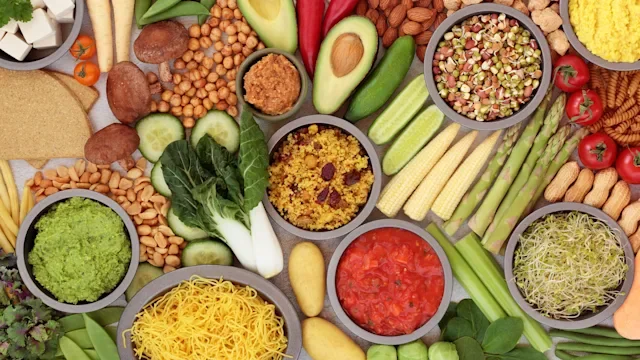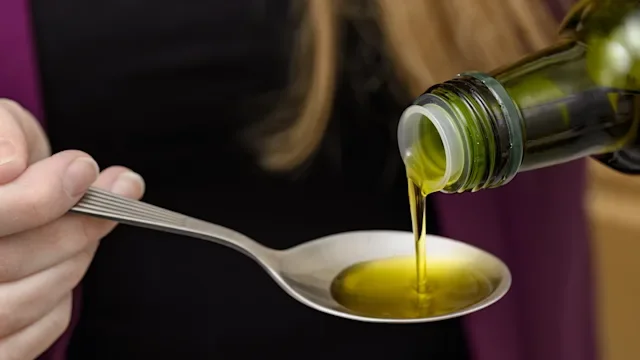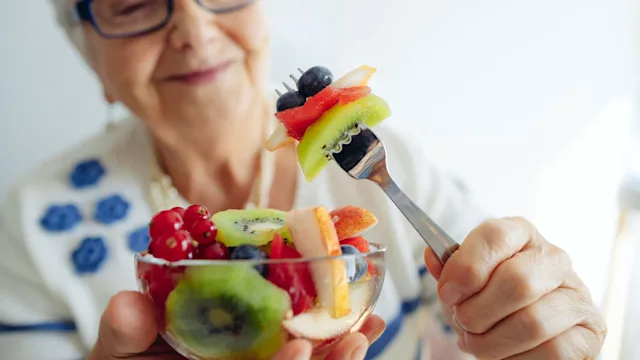Key takeaways:
Vitamin A is an essential, fat-soluble vitamin that plays a role in immune function, reproductive health, and growth and development. It also helps keep your heart, lungs, and eyes healthy.
Liver, certain fish, and dairy products contain preformed vitamin A. Fruits and vegetables that are orange and yellow in color contain beta-carotene, which your body can convert to vitamin A in smaller amounts.
Healthy adults should aim for 900 micrograms (mcg) of vitamin A per day. Most people in the U.S. get enough vitamin A in their diets.
Has anyone ever told you that eating carrots is good for your eyes? This is because it's high in vitamin A, which has a number of health benefits that extend well beyond eye health.
But carrots aren’t your only good source of vitamin A. It’s found in a wide variety of foods — from meats and dairy to fruits and vegetables.
Here, we share the benefits of vitamin A, the top nine food sources, and how to know if you’re getting enough.
What are the benefits of vitamin A?
Vitamin A is an essential vitamin for your health, with several benefits. It helps support:
Vision, especially during periods of dim light
Teeth and bone strength
Healthy skin and mucus membranes and skin
Immune function
Fetal growth during pregnancy (especially the heart, lungs, and eyes)
Reproductive (sperm and egg) health
9 foods high in vitamin A
Both plant and animal foods are sources of vitamin A. Meat, fish, and dairy foods contain preformed vitamin A: retinol and retinyl palmitate. Fruits and vegetables contain beta-carotene, a compound that converts to vitamin A in smaller amounts.
1. Beef liver
It's not the most popular food, but just 3 oz of beef liver provides a whopping 732% of the daily value for vitamin A.
The liver stores many vitamins and minerals for the body. That’s why it’s a very nutritious cut of meat. Pork liver and chicken liver are also options.
Beyond being a mega source of vitamin A, liver provides over 100% of the daily value of:
Vitamin B5
Vitamin B12
Copper
How much vitamin A is too much? Vitamin A toxicity is rare, but it’s possible. Learn more about how much vitamin A you should aim for every day to stay safe.
Vitamin A doesn’t prevent measles. But there are vaccines that can. Learn more about who needs one and when it’s time for a booster.
Do you actually need a multivitamin? As it turns out, these popular supplements may not be as beneficial as you think. We explain the research so you can decide.
And it provides half the daily value for:
Vitamin B3
Vitamin B6
Folate
Choline
Selenium
2. Sweet potato
One cup of baked sweet potato provides 287% of the daily value of vitamin A.
The bright color of orange and yellow fruits and vegetables comes from beta-carotene. Beta-carotene acts as an antioxidant in your body that turns into vitamin A in your intestines.
3. Butternut squash
One cup of cooked butternut squash provides 127% of the daily value of vitamin A.
Cooking the squash — baking, sauteing, or boiling — can increase the amount of beta carotene that your body absorbs.
4. Carrots
One cup of raw carrots provides 119% daily value of vitamin A.
But it’s a good idea to add a fat source with vitamin A foods to increase its absorption. Good options include:
Olive oil
Avocado
Nuts and seeds
A small amount of butter or cheese
5. Pumpkin
A half cup of pureed pumpkin provides 112% of your daily vitamin A.
Look for canned pumpkin, with pumpkin listed as the only ingredient. Pureed pumpkin is a simple way to kick up the nutrition of your soups, sauces, oatmeal, or dips. It can be used in sweet or savory dishes.
But keep in mind: This probably doesn’t apply to your favorite pumpkin-spice-flavored food items, which typically contain no actual pumpkin at all.
6. Collard greens
One cup of cooked collard greens provides 80% of the daily value for vitamin A.
Other greens like dandelion greens, turnip greens, and beet greens are nutritional powerhouses that contain vitamin A too.
7. Bluefin tuna
A 3 oz portion of bluefin tuna provides 71% of the daily value for vitamin A.
The larger the fish, the more it eats other fish that have vitamin A stores.
Bluefin tuna is higher in mercury than other fish, so pregnant people and children should only consume small amounts.
8. Spinach
Two cups of raw spinach provide 31% of the daily value of vitamin A.
It’s true that orange vegetables are better converted to vitamin A than leafy greens. But leafy greens also provide:
Vitamin C
Manganese
Magnesium
Folate
Vitamin K
9. Cantaloupe
One cup of cantaloupe provides 26% of the daily value for vitamin A.
As the fruit that’s highest in vitamin A, it makes a great addition to any snack. Or it can be pureed frozen for dessert.
What are the symptoms of low vitamin A?
Low vitamin A levels are rare in the U.S. But in some countries, vitamin A deficiency can be common in children under age 5.
It’s important to note that testing vitamin A levels in the blood isn’t always accurate. That’s because the test doesn’t measure the levels stored in the liver. But once the liver is depleted of its vitamin A stores, the following symptoms can appear:
Difficulty seeing at night
Higher risk of respiratory diseases, like pneumonia
Low blood counts, also called anemia
What about vitamin A deficiency and measles?
It’s important to note that low vitamin A is linked with severe measles. But that doesn’t mean that taking supplements can prevent or treat measles.
There’s some research showing that measles depletes the body’s vitamin A stores. In severe cases — especially in children — a healthcare professional may recommend large doses of vitamin A to boost the immune system to fight a severe measles infection.
How much vitamin A do you need every day?
The amount of vitamin A you need every day depends on your age and sex. Here’s how much vitamin A adults over age 19 should aim for per day:
Men: 900 micrograms (mcg)
Women: 700 mcg
Children and teenagers need less than this, and it varies based on their age.
Some people may need to get more vitamin A in their diet, as follows:
If you’re pregnant, you need 770 mcg per day.
If you’re nursing, you need 1,300 mcg per day.
If you regularly drink alcohol, you may need higher amounts of vitamin A. This is because both processes — vitamin A metabolism and alcohol metabolism — rely on the same enzymes to break them down.
Vitamin A isn’t required to be listed on food labels. So it can be tough to know if you’re getting enough.
Can you have too much vitamin A?
Yes, you can get too much vitamin A. This is because it’s a fat-soluble vitamin that’s stored in the liver. So the body can’t easily get rid of excess vitamin A.
The maximum amount of vitamin A is 3,000 mcg per day for adults. The upper limits of vitamin A are even lower for children.
It’s rare to get too much vitamin A from food. This usually only happens if someone is taking dietary supplements. Symptoms of vitamin A toxicity including:
Skin irritation
Blurry vision
Headache
Nausea
The bottom line
Vitamin A is an essential, fat-soluble vitamin found in several different categories of food. The top food sources of vitamin A include liver, orange fruits and vegetables, leafy greens, and some fish and dairy products. Most people in the U.S. get enough vitamin A. So you don’t need to take a supplement. Also, too much vitamin A can be bad for you. So you should only take extra vitamin A if recommended by a healthcare professional you trust.

Why trust our experts?


References
American Academy of Pediatrics. (2025). Fact checked: Vitamin A does not prevent measles.
Clagett-Dame, M., et al. (2011). Vitamin A in reproduction and development. Nutrients.
Clugston, R.D., et al. (2012). The adverse effects of alcohol on vitamin A metabolism. Nutrients.
Institute of Medicine. (2001). Vitamin A. Dietary Reference Intakes for Vitamin A, Vitamin K, Arsenic, Boron, Chromium, Copper, Iodine, Iron, Manganese, Molybdenum, Nickel, Silicon, Vanadium, and Zinc. The National Academies Press.
McEldrew, E.P., et al. (2025). Vitamin A. StatPearls.
MedicinePlus. (2023). Vitamin A.
My Food Data. (n.d). Canned pumpkin nutrition facts.
My Food Data. (n.d.). Cantaloupe melons nutrition facts.
My Food Data. (n.d.). Cooked bluefin tuna nutrition facts.
My Food Data. (n.d.). Cooked butternut squash (baked) nutrition facts.
My Food Data. (n.d.). Cooked collards nutrition facts.
My Food Data. (n.d.). Pan fried beef liver nutrition facts.
My Food Data. (n.d.). Raw carrots nutrition facts.
My Food Data. (n.d.). Raw spinach nutrition facts.
My Food Data. (n.d.). Raw sweet potatoes nutrition facts.
Office of Dietary Supplements.. (2025). Vitamin A and carotenoids. National Institutes of Health.
Tabussam, T., et al. (2024). Nutritional benefits of lycopene and beta-carotene:a comprehensive overview. Food Science & Nutrition.














